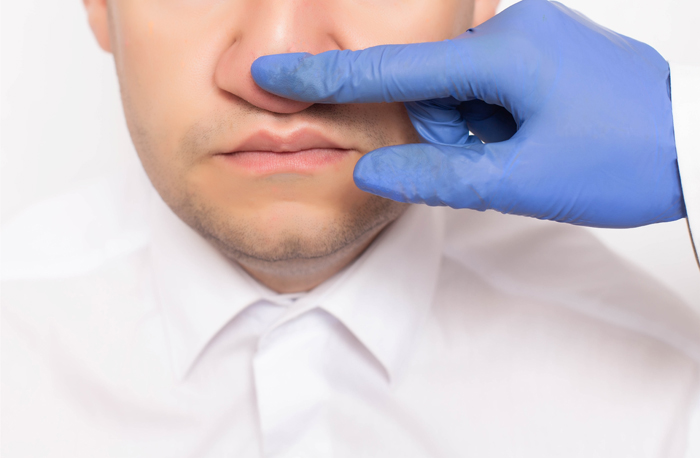Saddle Nose Deformity Treatment in Kondapur, Hyderabad
Nasal deformities can come from a congenital flaw, a traumatic accident, or a medical condition, and they can give you an odd look. Cosmetic and functional nasal abnormalities can be distinguished. The physical appearance of the nose is impacted by cosmetic nasal abnormalities.
The function of the nose is affected by functional nasal deformities, which can cause breathing issues, sinuses, snoring, smell, and taste.
What Are Nasal deformities?
Nasal deformities are deviations in the nose's shape or structure. A deformity can occur as a result of trauma or injury in some circumstances. In other situations, the deformity may be something that the kid was born with, such as a cleft lip and palate deformity.
While learning that your kid has a cleft lip or similar nasal abnormality might be upsetting, keep in mind that there are therapeutic alternatives.

What Are the Symptoms of Nasal deformities?
The most frequent symptom of nasal abnormalities, whether evident on the outside or concealed inside, is trouble breathing. The symptoms of a nasal deformity vary depending on the underlying cause and condition. The following are some of the symptoms of functional and aesthetic nasal deformities:
- Snoring
- Loud breathing
- Congestion
- Sleep apnea
- A diminished sense of smell or taste
- Mouth breathing
- Chronic sinusitis (inflammation of the sinus passages)
- Frequent bloody noses
- Facial pain or pressure
- Frequent sinus infections
Nasal deformity prognosis
Although a nasal deformity might create breathing difficulties, it is not a dangerous condition that will interfere with your everyday activities. However, if breathing becomes difficult on a regular basis, it can lead to sleep apnoea and poor sleep quality. With age, both respiratory difficulties and aesthetics tend to worsen.
Nasal abnormalities can cause a variety of symptoms, including:
- Blockage of one or both nostrils - this can make breathing difficult and is more obvious when you have a cold or an allergy that causes the nostrils to become inflamed and constricted.
If the surface of your nose dries up, you may get more nosebleeds. - Facial discomfort - a nasal abnormality can occasionally cause facial pain.
- Loud breathing while sleeping - this is caused by irritating tissue within the nose. It's prevalent in babies and kids who have a deviated septum.
- Nasal cycle - The nasal cycle occurs when the nose is blocked on one side or the other alternately. This is normal, but if it occurs frequently, it might indicate an aberrant blockage.
- Sleeping on one side is preferred. Because of a deviated nasal septum, some people prefer to sleep on one side at night to optimize nasal breathing.
When to See a Doctor?
When an issue with your nose affects your quality of life, it's worth consulting a doctor. If your nose's outward look is causing you anxiety to the point that you don't want to have pictures taken of it, or in more severe situations, you don't want to go out because you're self-conscious, it's time to see your doctor. Initially, you would see your primary care physician, and then, most likely, a specialist.
The other internal difficulties are more functional; for example, if your nose is clogged and you can't breathe correctly, that's a problem during the day, but at night, these issues may be particularly bothersome for those attempting to sleep.
Request an appointment at Apollo Spectra Hospitals, Kondapur
Call 1860-500-2244 to book an appointment
How Is Nasal Deformity Diagnosed?
The inside and exterior of the nose will be examined by the doctor at Apollo Kondapur. For the inside inspection, a fiberscope (a camera connected to a flexible optical fibre) is utilized. The specialist can use this equipment to examine if there's a mechanical obstruction or if your nose collapses when you breathe in.
This inspection permits the cosmetic and functional issues to be diagnosed. The specialist will next explain with you the issues that need to be addressed, as well as the surgical procedures that will be used and the strategy that will be taken.
How Can We Treat Nasal deformity?
Antihistamines, decongestants, steroid sprays and Analgesics, are among the medicines available to treat the symptoms of nasal deformities.
Surgery, on the other hand, is the only true answer to the problem. A rhinoplasty, which reshapes the nose, or a septoplasty, which surgically straightens the cartilage between the nostrils, are two options.
Because no two noses are alike, the specialist will first plan and personalize the procedure. The functional and cosmetic problem is generally corrected in one and a half to two hours of surgery. The majority of patients are discharged the same day, with the final findings appearing three to four months later.
The phrase "deformity" may conjure up images of something disfiguring, but it's a medical term describing "normal" anatomical abnormalities.
In some people's imaginations, the word deformity conjures up images of disfigurement. In actuality, though, a deformity may not be very disfiguring. The word may appear excessively harsh to anyone reading it while researching nose problems, and they may say to themselves, "I'm not malformed."
Facial trauma - Trauma to the nose or face that results in fractures can change the look of the nose. The ideal time to repair these fractures is within a week following the accident. The sort of surgery necessary is very customized, depending on the degree of the injury or accompanying symptoms.
A hole in the partition that divides the two nasal passageways is known as a nasal septum perforation. Trauma, drug use, and infections, among other things, can cause this. regularly
When a malformation is identified, a referral to an ear, nose, and throat expert should be made as soon as possible since certain repairs are time-sensitive. Please call your primary care provider as soon as possible following an injury if you have any questions about a prospective referral.
Congenital (present at birth) and acquired causes can be distinguished.
Symptoms
Our Doctors
DR. MOHAMMED NASEERUDDIN
MBBS, MS (ENT)...
| Experience | : | 8 Yeras Experience |
|---|---|---|
| Speciality | : | ENT, Head and Neck S... | Location | : | Kondapur |
| Timings | : | Mon - Sat : 11:00AM... |
DR. PUROHITHI P
MBBS, MD, IDRA, FIPM...
| Experience | : | 4 Yeras Experience |
|---|---|---|
| Speciality | : | Sr. Interventional P... | Location | : | Kondapur |
| Timings | : | Mon - Sat : 5:00 PM ... |
DR. CHINNAYA PARIMI
MBBS, FACS (Fellow, ...
| Experience | : | 19 Yeras Experience |
|---|---|---|
| Speciality | : | General Surgery & Ga... | Location | : | Kondapur |
| Timings | : | Mon - Sat: 9:30 AM t... |
Our Top Specialities
NOTICE BOARD
CONTACT US
CONTACT US
 Book Appointment
Book Appointment





.svg)
.svg)
.svg)
.svg)








